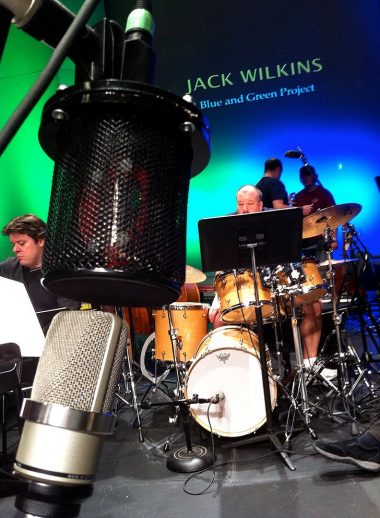Rick Earl knows how to build a working microphone using just plastic cups and a little bit of wire. So when Earl, technical director for cultural and special programs, couldn’t find an affordable classic directional microphone, he decided to take matters into his own hands and build his own model.
“I have always been intrigued by them; the more I learned about them, the more I realized that I could build one,” Earl says. “The idea was to see if I could, but it also became a teaching tool for me.”
Putting his knowledge of the sound industry to good use, Earl is in the process of finalizing a model of a ribbon microphone that can be sold as a production kit.
Ribbon microphones were used in the early film industry. Though they were replaced in the late 1940s, Earl says they are enjoying a resurgence.

“There are probably more people who use a ribbon microphone now than there were back in the heyday,” he says.
Earl finalized the first model of the product two years ago and introduced it at the Elon Jazz Festival, which the university hosts every year. One of the clinicians, a saxophone player, was interested in the microphone and decided to use it during a live performance.
“A lot of microphones that are popular have a really crisp and clear high end,” Earl says of the sound quality of the microphone. “These have a nice high-end but it is a much fuller, richer sound. Things like reeds or brass can be harsh through a sound system, while this tends to mellow them nicely.”
Though the musician wanted to purchase one at the time, Earl did not want to sell his prototype. That’s when he embarked on this mission: to create a ribbon microphone that could be recreated multiple times and that also served as a teaching tool.
How does a ribbon microphone work?
Ribbon microphones form the basis for almost all directional microphones. To understand how these work, it’s important to know their directional characteristics.
In the middle of the microphone, there is a corrugated aluminum ribbon surrounded by a magnet on either side. A wire runs from the top to the bottom. When sound waves enter the microphone and travel past the ribbon, it vibrates within the magnetic field and creates an electric current, which is then magnified by a transformer at the bottom.
Sound waves must enter from a very defined point on either side of the microphone in order to be picked up and act on the ribbon. If the microphone is turned sideways, sound cannot be picked up. To make it directional, there are ports on the back designed to slow down sound when it enters, giving other sound waves time to travel to the front and arrive at the same time.
“They’re rather simple to make but a lot of people want them and it’s a good learning process,” he says.
It has certainly been that for Earl. He says this process has taught him about the difficult choices inventors face, particularly when it comes to production cost. For instance, rather than spending extra money on an external frame for the microphone, he opted for a pencil cup. As a consumer, he says, you don’t think about those choices.
“When you want to buy something, you just go buy it,” he says. “But anything extra you want comes into play with how much something costs” to produce.
Earl says the hardest part of the process has been writing the instructions for the kit clear enough for anyone to understand.
“I designed it so I can put it together without the instructions,” he says. “I’ve asked people who have an understanding of how microphones work to try it and I’ve given it to people who have no clue. So far, so good.”
Though he had hoped to have the kit completed by now, Earl says he is finalizing the instructions and waiting for a few materials to arrive before it hits the market.
So far, the kit has been advertised entirely by word-of-mouth and he says he already has a few interested customers, including musicians who have visited Elon and even students on campus.
“I really want to get the first few out there with these people to see how it goes,” he says. “If I gave you these pieces, I’m watching you do it. There’s a difference when I send these out and people are on their own.”
Though he does not have a complete marketing strategy yet, Earl anticipates the kit will cost around $200. Other ribbon microphones range in price from a few hundred dollars to $4,000.
Earl says he is trying to find someone to handle the sales. He’s even considered approaching a company in Oklahoma that makes kits for musicians to sell or license his product to them.
“It’s been fun, especially as people have poked their heads into my office to see what I’m working on,” he says. “At home, I have microphone pieces scattered across the kitchen table. I’m sure everyone at home is anxious for me to get those out of there.”
By Caitlin O’Donnell ’13


